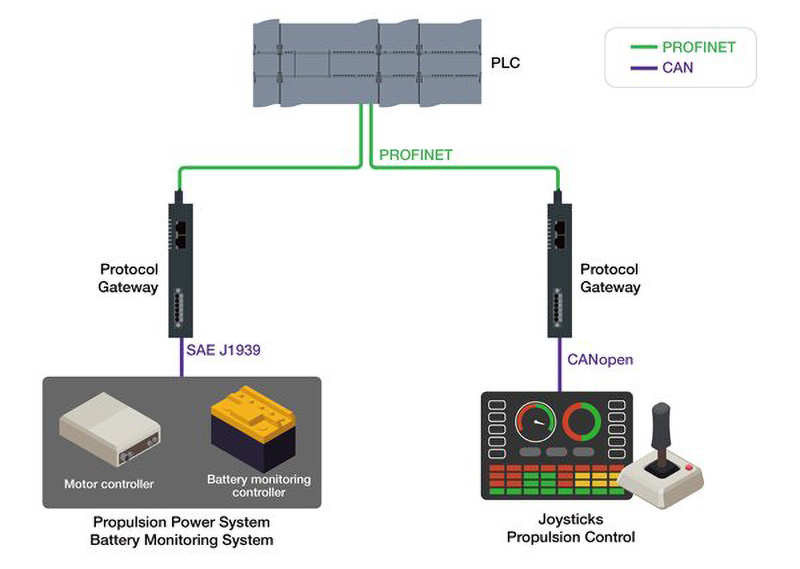Resources / Featured Topics
Not Just for Cars: Exploring CANbus Technology in Diverse Industrial Landscapes

The Controller Area Network (CAN) protocol, developed by Robert Bosch GmbH in the 1980s for automotive communication, has become an integral component of many modern industrial networks. Originally designed to streamline communication between electronic control units (ECUs) in vehicles, CANbus has since moved past its automotive origins to optimize applications in different industrial sectors, notably in renewable energy and industrial control systems. This article explores the key features that make CANbus the preferred choice for industrial networking professionals, highlighting its practical applications across various industrial scenarios.
From Automotive to Industrial Applications: A Seamless Transition
CANbus' success in the automotive industry shows its ability to connect systems with efficiency and reliability. These qualities translate seamlessly to industrial automation, especially in energy storage systems. Just as CANbus coordinates communication between various control units in vehicles, it now plays a crucial role in managing energy storage in renewable energy installations. These systems often involve multiple battery units, inverters, and other components that require seamless communication to optimize energy generation, storage, and distribution. CANbus provides the robust and efficient communication backbone necessary for these intricate systems to function effectively. While CANbus is a natural fit for energy systems, its features also translate into real benefits for a broad range of other industrial applications.
Key Features Driving CANbus Adoption
Industrial engineers have identified several key features of the CANbus protocol that have sped up its widespread adoption in different industrial applications. In the following section, we will explore these key features and how they create practical benefits for different industries.
1. Simplified Wiring
In complex industrial networks, traditional point-to-point wiring can be cumbersome. CANbus avoids this obstacle with its two-wire bus and bus topology. By eliminating the need for many individual connections, CANbus helps reduce cable clutter and installation complexity, resulting in more flexible and more organized wiring architectures.

The benefit of simplified wiring has been on prominent display in the marine industry, where CANbus gateways are being deployed to connect onboard systems for propulsion and battery monitoring. With space at a premium, using compact gateways allows marine vessel operators to leverage CANbus to reduce cabling and costs, while making optimal use of the limited space onboard.

2. Robust Communication
Industrial environments often present harsh conditions with extreme temperatures, vibrations, and electromagnetic interference. CANbus excels in these conditions thanks to its differential signaling and error detection mechanisms. Differential signaling ensures reliable data transmission even in the presence of electrical noise while support for error detection, data acknowledgment, and re-transmission help guarantee data integrity.
These robust features of CANbus play a major role when used in industrial applications with high levels of electromagnetic interference, such as inside wind turbine generators. By deploying protocol gateways, wind farm operators can connect turbine components using CANbus and send data over different protocols to a monitoring interface. The highly resistant nature of CANbus means data transmissions are not affected by the electrical noise generated inside the turbine, ensuring engineers are always receiving accurate data.

3. Real-time Control
For time-critical industrial applications that require accurate control, real-time control capabilities are crucial. However, unlike CANbus, traditional mainstream serial communication protocols do not support this functionality. CANbus prioritizes critical control commands to make sure they are always processed first. CANbus achieves this through message prioritization and arbitration. This process guarantees that critical tasks receive the necessary bandwidth and are not interrupted.
This ability to reliably process critical data makes CANbus the protocol of choice in applications that require precise synchronization and instant response, such as critical fire alarm systems. For such warning systems to be effective, all components including smoke detectors, alarm lights, and buzzers, must be synchronized throughout the entire site. By connecting these components over CANbus, engineers can leverage its data prioritization features to ensure that all systems respond instantly in the event of an emergency. In addition, engineers can deploy CAN-to-fiber converters to easily extend the advantage of CANbus communication to connect fire systems across different sites over long distances.

-
4. Streamlined Integration
The CAN 2.0A/B and CAN FD standards define the foundational layers of communication. Based on specific requirements, industries can define additional higher-layer protocols to provide standardized frameworks for device profiles and communication objects. Some examples of high-level CANbus protocols are CANopen, J1939, and DeviceNet. These protocols communicate over the same CAN data layer standards, enhancing interoperability and simplifying the integration of different systems.

A great demonstration of this versatility in practice is the use of CANbus in medical equipment. By installing space-efficient CANbus interface cards into IPCs embedded in medical machines, the system builder can integrate various medical systems such as patient monitors, blood pumps, and oxygen generators that operate on different higher-layer protocols such as CANopen or J1939.
Empowering Industrial Applications Through Versatility
CANbus has become an indispensable asset for various industrial sectors, from the automotive industry that developed the technology, to other sectors like renewable energy and building automation. The combination of simplified wiring, robust communication characteristics, and real-time control capabilities makes CANbus a highly versatile tool for industrial engineers. The ability to tailor its use through higher-layer protocols further enhances its flexibility, allowing engineers to easily integrate CANbus into a wide range of applications. These features make it an appealing choice for engineers who are looking for a cost-effective, dependable, scalable, and efficient means to connect complex systems.
Whether you’re optimizing energy storage systems, automating a production line, or integrating control systems, CANbus offers a lot of potential to improve efficiency and reliability in a wide range of industrial applications.
Moxa Solutions
Moxa offers a broad portfolio of solutions to help you empower your industrial applications with the advantages of CANbus. Visit the microsite for more information about our comprehensive CANbus product offering.